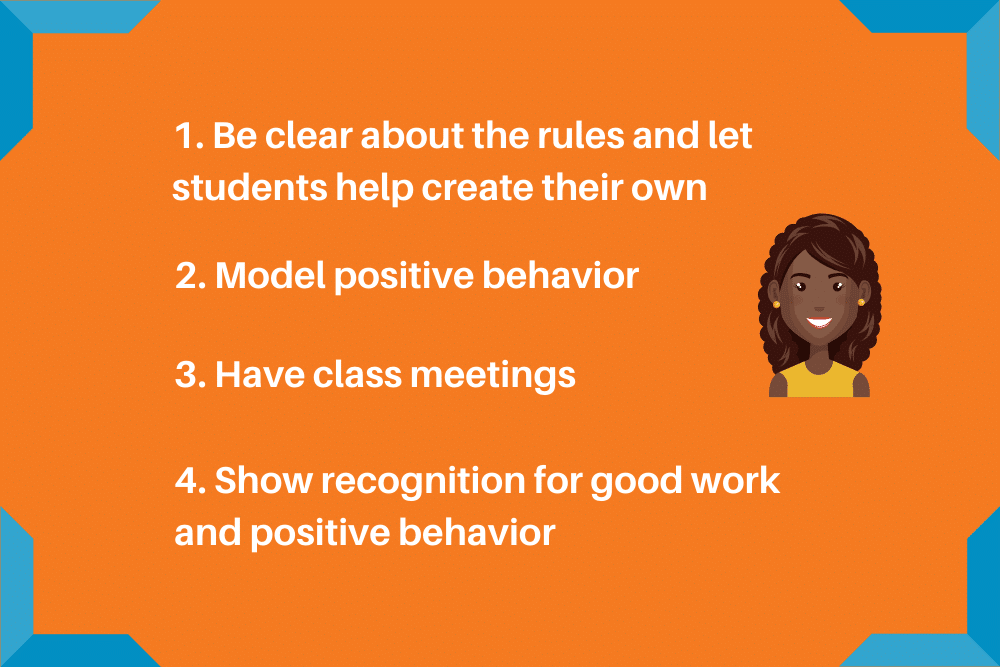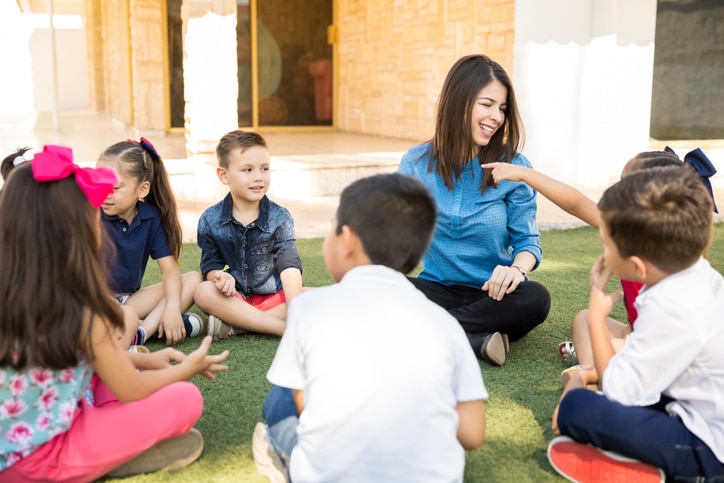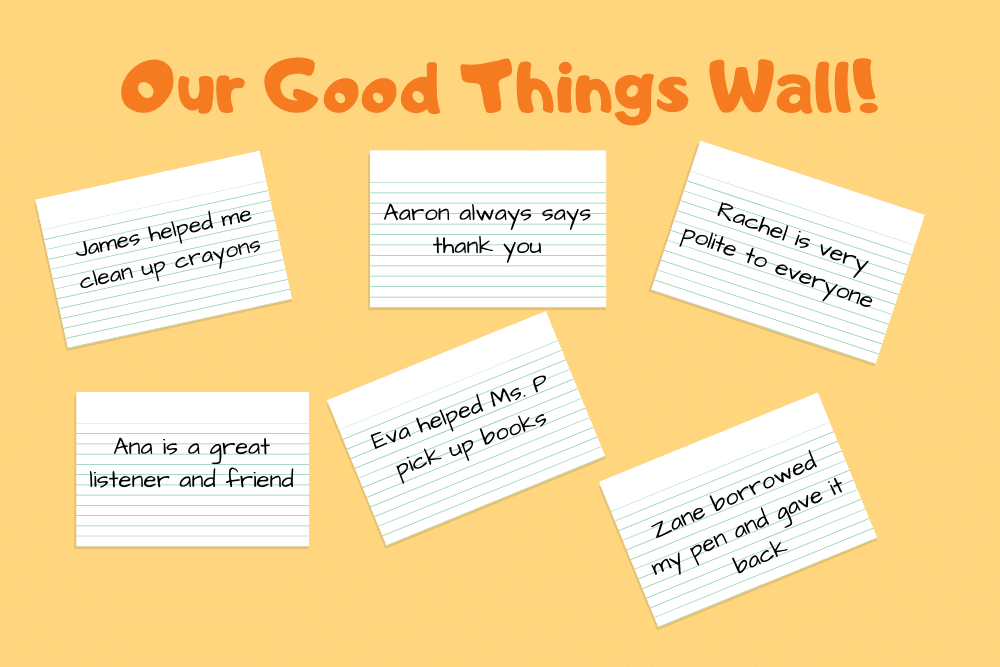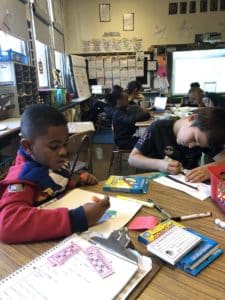 Wouldn’t it be great if we could all just wave a magic wand and our students would suddenly have great behavior and their work done? Unfortunately, technology isn’t quite there yet and it would be a little unsettling if it was.
Wouldn’t it be great if we could all just wave a magic wand and our students would suddenly have great behavior and their work done? Unfortunately, technology isn’t quite there yet and it would be a little unsettling if it was.
The closest thing we have to a magic wand right now are classroom management techniques and strategies to help your students understand what good behavior looks like.
Table of Contents:
- What is Classroom Management
- Classroom Management Priorities
- Building Trust and Relationships
- Techniques for Facilitating Good Behavior
- Tips for Addressing Misbehavior in the Classroom
- Activities that Promote Positive Behavior
Below, we have outlined a few classroom management techniques that will help create a classroom that is a safe and happy place for your students. Before we get into those techniques, let’s answer the question, “What is classroom management?”
What is Classroom Management?
Classroom management is a variety of skills, techniques and strategies that teachers like you use to help their classrooms run smoothly.
It boils down to having a structured learning environment with rules that promote learning and clear consequences that diminish behaviors that get in the way of learning.
It is important to note that classroom management can vary from classroom to classroom and is somewhat dependent on the age of the students, style of teaching and your own personality.
For example, if you are a 5th grade teacher who is laid back, you will have a different approach to classroom management than a 2nd grade teacher who is very structured and routine driven. Which is absolutely okay. Over time, you will find out what works for you and the students!
Classroom Management Priorities
There are essentially four priorities you should think about when it comes to classroom management.
- Keeping your students emotionally and physically safe
- Developing strong working relationships with your students
- Establishing standards of good behavior
- Appropriately addressing misbehavior
In addition to these priorities, you will also need to make sure your students understand time management and how learning works in your classroom so that everything runs smoothly and lessons are effective and completed on schedule.
Building Trust and Relationships
One of the first things you should look at when evaluating your classroom management strategy is your relationship with your students and the level of trust they have in you. This trust is crucial to successful classroom management.
Investing time to get to know each one of them as individuals builds trust. This takes time but will pay off tenfold and prevent disruptions before they happen. Important things to focus on as you get to know your students better are:
- Strengths
- Weaknesses
- Personal challenges
- Interests
You should take some time out of the day to encourage activities and practices that build social-emotional skills. This time not only will help you get to know your students better, but it will also build a stronger classroom community which we will talk about shortly.
Are you Enjoying this Content?
Ways to Encourage Social-Emotional Learning
- Use writing prompts and activities geared towards social-emotional learning
- Discuss managing emotions
- Encourage positive self-talk
- Have short daily or weekly check-ins
- Celebrate diversity
- Give your students reflection time
What we have outlined above is a great start to building a strong classroom community and positive relationships with your students. In addition to the things above, you should also incorporate creative projects that promote teamwork.
Choose projects like putting together a class vision board or creating a classbook that everyone can be involved in.
These types of projects allow your students to work both independently and as a whole to put together something uniquely special that they will be proud of. You will also learn a thing or two about them that you didn’t know before!
Another thing that you can do to understand your students better is invite them individually to come eat lunch with you in the classroom. You will be surprised how much they will share in that 20-30 minute time-frame.
As you probably know, some of your students respond extremely well to rules and follow them to a T, while others have a harder time with rules and authority.
Techniques for Facilitating Positive Behavior
Now that you know how important it is to build trust with your students, let’s talk about a few things you can do to establish good behavior in your classroom.

1. Be clear about the rules and let students help create their own
There are rules you absolutely need in the classroom for the well-being of your students and you cannot waiver on those.
These rules include things like no cheating, no violence, no stealing, etc.
You need to make sure each of your students understands these rules and if one is broken, have a class discussion about the rules again. This discussion should be general and about each rule. Do not call out the student(s) who broke the rule.
In addition to those set-in-stone rules, talk to your students about the rules that they would like to see in the classroom. You can get the conversation rolling with a bare-bones set of general rules like:
- Treat others as you would like to be treated.
- Don’t laugh at others
- Come to class ready to learn
- Share with others
Then, have your students come up with their own ideas for rules they think should be adapted or added to the list.
Post a complete list of rules throughout the classroom where everyone can see them.
The list can be adapted and changed throughout the year and discussed in class meetings, which brings us to our next technique.
2. Model positive behavior
Modeling positive behavior is one of the best ways to show your students how they should behave and takes almost no extra effort or time away from the day.
Your students look up to you as a role model and for guidance. Take this responsibility seriously and use it to show your students what they should and should not do.
It isn’t difficult, it just takes some self-awareness on your part.
Another thing to be aware of when modeling positive behavior is to be consistent. Make sure that if you tell your students that you always double-check your math, then be sure you always double-check your math when presenting a lesson to them.
3. Have class meetings
Class meetings are a great time to check in with everyone as a whole. You can choose to have them every day or every week depending on what you think is necessary for classroom management success.
Class meetings allow your students to express their feelings and emotions in a constructive way while learning to show gratitude, give compliments and/or solve problems as a group.
Establish a few rules for your class meetings such as: don’t talk over others, don’t judge or make fun of others, and don’t yell.

Remind your students of the rules you put in place before the meeting.
You can start meetings by going around and asking everyone how they are feeling and why they are feeling that way. If you see that multiple students are bringing up the same thing, that is something you can discuss further during the meeting.
If everyone seems to be doing fine that day, ask if there are any challenges that the class can help solve.
You don’t necessarily have to follow this formula exactly but you can use it as a guide to start your own class meetings.
You can also call emergency class meetings if needed. If something particularly concerning happens to the class as a whole, it is a good idea to have everyone sit down and discuss how they feel about the situation.
4. Show recognition for good work and positive behavior
Reinforce classroom expectations regularly by praising those demonstrating positive behavior and doing what they are supposed to.
You probably have a few students who are always helpful, have great behavior and do their work without any issue. It is very important to make sure that you do not favor only these students when providing praise and recognition but spread it out amongst your class. Remember, praising even the little things can make a huge difference!
Tips for Addressing Misbehavior in the Classroom
Just like how demonstrating that good behavior receives praise and recognition, it is important to show your class that not following the rules has consequences.
No matter what you do, you will have students who act out every once in a while. You will need to have a plan and procedure for when this happens. Here are a few tips to help you out when one of your students does misbehave:
- Remain calm.
- Take a few seconds to observe the situation so you can note exactly what is going on.
- Address the student by name to signal them to stop.
- Do not blame or ridicule them.
- Use problem-solving instead of punishment.
- If speaking to a student individually, do it in private.
- Tell the student that it’s their misbehavior you dislike, not them.
Activities That Promote Positive Behavior
You can plan lessons and activities that help your students better understand and appreciate what positive behavior is.
Create a good things wall

A good things wall is where students can showcase the good deeds their classmates did.
At the end of the week, have each student take out a notecard and write down a good thing that they noticed one of their classmates did that week.
After everyone has written their good thing down, have them share the good thing with the class and put it on the wall.
This is a fantastic way to show your students how their behavior affects others and positively reinforce good behavior and kindness.
Create a positive behavior contract
This activity is great for after you establish your rules in the classroom. Have your students help you create a contract that states what the rules are and that everyone will follow them.
Everyone will sign the contract - including you - and you can refer to the contract throughout the year as needed when negative behavior occurs.
Although this may not be the most fun activity on this list, your students will feel that there is a mutual respect between you and them by creating this agreement.
Put out appreciation boxes
An appreciation box is somewhat similar to the good things wall but it is a bit more personal.
Have your students create appreciation boxes, write their name on the outside, decorate them and tape the box to the edge of their desk or table.
Whenever a student does something positive or nice for another student, have them write down why they appreciated the action, say thank you and put it in the appreciation box.
You can also write down things to put in your students’ appreciation boxes. They are great for shy students who don’t like to be called out in class.
Your students will likely be excited when something arrives in their appreciation box and share it with the other students. The other students will then want to receive notes in their boxes and their behavior will likely change in order to receive notes.
Have them write about why it is good to show positive behavior
Writing often can help students better explore and be open with their feelings.

They can use examples from their own lives to write about why showing good behavior is a positive thing.
If you combine this with the good things wall and appreciation boxes, your students will be able to write about how their positive behavior affects others.
You can make this into a fun class project by having them add illustrations and publishing their writing into a classbook that reminds them of why they should show positive behavior.
With the tools, techniques, and activities above, you will be better able to manage your classroom and student behavior while creating an ideal learning environment for your students.
Additional Resources
For more classroom activities and other free creative writing resources, check out our online teacher’s lounge, and be sure to sign up for your free publishing kit!






